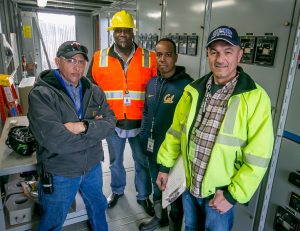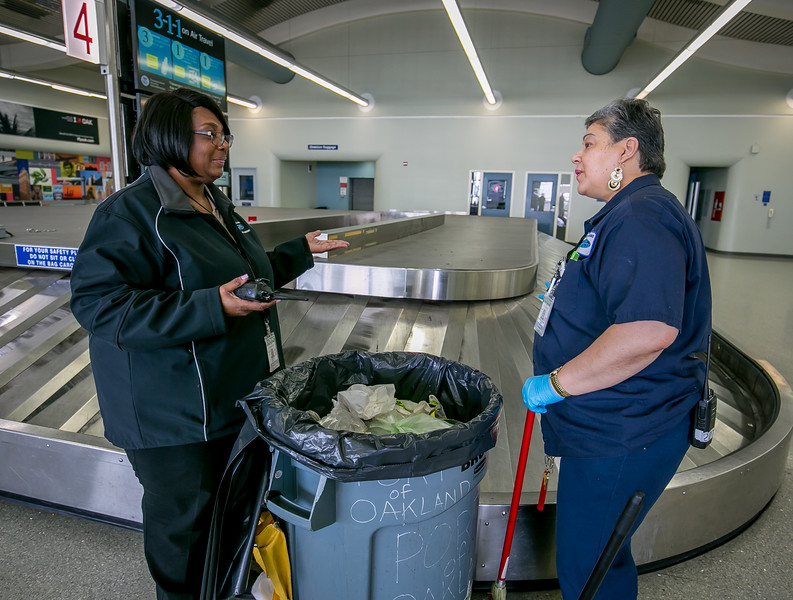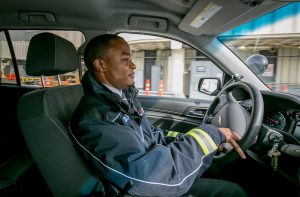Among Bay Area natives, Oakland is known colloquially as “The Town.” But with nearly half a million residents, an emerging art scene, a booming tourism industry, and a growing number of cutting-edge start-ups, Oakland has come a long way from its small-town roots.
All of these changes have led to an increasing number of people visiting, living and working in Oakland – and that’s put a lot of added wear and tear on The Town’s transit infrastructure. Fortunately, the IBEW 1245 members who are employed by the city, as well as its port and road transit system, work day in and day out to ensure that residents and visitors alike are able to travel to, from and around Oakland safely and smoothly.
In the Street

IBEW 1245 members Raymond Tse (on the ground) and Michael Patterson (in the bucket) work on a traffic signal at the intersection of Broadway and Keith in downtown Oakland
The Bay Area is known for its heavy traffic, and Oakland is no exception. In an effort to ensure that some of the most high-traffic areas are functional for drivers, bikers and pedestrians, the city has been updating its infrastructure to allow everyone to move through Oakland’s busiest areas with ease.
IBEW 1245 member Michael Patterson, lead electrician in the city’s traffic signal department, explained his team’s role in one such upgrade that he worked on at the corner of Broadway and Keith near the Highway 24 off ramp.
“They reconfigured this intersection, put in a lot of new traffic signals and video detection cameras … and it’s our job as the electricians to come out and program the controller to make sure everything works,” he explained. “So what we’re doing today is adding a ‘No Right Turn’ [indicator] for drivers coming up Keith Street. We have to program that logic into the controller, so when people are crossing [on foot or bike], the vehicles will see the ‘No Right Turn’ signal.”
By the Water
Local 1245 also represents a small but mighty group of workers at the Port of Oakland, which encompasses Oakland’s busy seaport, as well as its international airport. Local 1245-represented classifications at the port include many high-ranking jobs, from foremen and managers to supervisors and even superintendents in both the air and maritime divisions.
Local 1245 member Dion Bailey works as an airport duty manager, where he and his team oversee much of the day-to-day operations at Oakland’s bustling airport – and there’s rarely a dull moment, with upwards of 11 million passenger flights and an additional million cargo flights going in and out of Oakland each year.
“Our job is to maintain normal operations – but it’s an airport, so there’s always some sort of delay or service interruption, and it’s our job to put it back together,” said Bailey, noting that his work group also coordinates with the local police and fire departments as needed.
The Federal Aviation Administration, which maintains strict guidelines for all airport operations in the U.S., has a heavy hand in the work that Bailey and his colleagues perform each day.
“A large part of our job involves [FAA] compliance,” Bailey said. “We do lots of inspections, and we also run the dispatch center at the airport.”
On the Bus
With 155 bus lines, 364 square miles of service area, and more than 171,000 riders using the system on any given day, Oakland’s public transit service, known as AC Transit, is one of the busiest public bus services in the state. In addition to serving The Town, AC transit also picks up and drops off riders in 12 nearby cities, as well as adjacent unincorporated areas in Alameda and Contra Costa counties.
AC Transit’s buses travel nearly 20 million miles collectively over the course of the year – and that means they need a team of skilled and dedicated mechanics, techs and electricians working around the clock to ensure that the vehicles continue to operate exactly as they should.
The Utility Reporter caught up with AC Transit Senior Electronic Tech Arnel Samson as he worked on a bus’s keypad.
“This is the ODK keypad that controls the head sign, and sometimes it’s working, sometimes it’s not,” said Samson, a newcomer to Local 1245. “So we need to replace it, and we’ll fix this one later in the shop.”
Union Town

IBEW 1245 members from the Port of Oakland (left to right), Terry Padilla, Darryl Edwards, Kevin Pittman, and Eddie Villasenor
Oakland is well known for being a union town, and the Local 1245 members who help keep the city running are proud to be a part of the city’s united labor movement. During the highly publicized city-wide contract negotiations that came to a head in late 2017, the Local 1245 members employed by the city stood in solidarity with SEIU 1021 and other unions that were fighting for a fair contract, even though IBEW 1245 was eminently close to settling their own contract. IBEW 1245 reached a tentative agreement with the City on the fourth day of the city-wide strike. The other unions did not reach a tentative agreement until several months later.
“While the other unions were still in negotiations, a [Local 1245] member came to me and said he was glad to be in our union, because of what we were able to get with the contract,” said Patterson, who is a shop steward and served on the bargaining committee.
Local 1245 members at the Port and AC Transit echoed that sentiment.
“[Before hiring on at AC Transit] I worked before as an electronic tech at different companies, with no union, no support. When management would tell me to do something, I had no choice,” said Samson. “But now I can consult my shop steward, and they assist us, and the whole team. It’s a lot better.”
“[The union] fights hard for our employees, so that we have good benefits, salaries and working conditions,” said Bailey, who is also a union shop steward. “I like being able to help out my co-workers with their work issues, and I appreciate being a part of the negotiations to help our whole group achieve better wages and working conditions.”
–Rebecca Band, IBEW 1245 Communications Director
Photos by John Storey

IBEW 1245 members Michael Patterson and Raymond Tse, (left) program a street light

IBEW 1245 member Jayzelle Norflin (left) with janitor Elsie Valentin-Miguel at the Oakland Airport

IBEW 1245 member Al Johnson works on a fare box for AC Transit

IBEW member Abe Dayauon Jr. refurbishes a fare box for a bus

IBEW member Kevin Auer works on a boiler for AC Transit

IBEW 1245 member Paul Lonestar checks the boom on his truck as he gets ready for work at the City of Oakland


